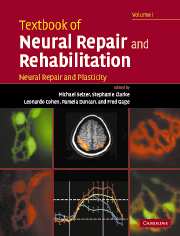Book contents
- Frontmatter
- Contents
- Contents (contents of Volume II)
- Preface
- Contributors (contributors of Volume I)
- Contributors (contributors of Volume II)
- Neural repair and rehabilitation: an introduction
- Section A Neural plasticity
- Section A1 Cellular and molecular mechanisms of neural plasticity
- Section A2 Functional plasticity in CNS system
- 6 Plasticity of mature and developing somatosensory systems
- 7 Activity-dependent plasticity in the intact spinal cord
- 8 Plasticity of cerebral motor functions: implications for repair and rehabilitation
- 9 Plasticity in visual connections: retinal ganglion cell axonal development and regeneration
- 10 Plasticity in auditory functions
- 11 Cross-modal plasticity in sensory systems
- 12 Attentional modulation of cortical plasticity
- Section A3 Plasticity after injury to the CNS
- Section B1 Neural repair
- Section B2 Determinants of regeneration in the injured nervous system
- Section B3 Promotion of regeneration in the injured nervous system
- Section B4 Translational research: application to human neural injury
- Index
9 - Plasticity in visual connections: retinal ganglion cell axonal development and regeneration
from Section A2 - Functional plasticity in CNS system
Published online by Cambridge University Press: 05 March 2012
- Frontmatter
- Contents
- Contents (contents of Volume II)
- Preface
- Contributors (contributors of Volume I)
- Contributors (contributors of Volume II)
- Neural repair and rehabilitation: an introduction
- Section A Neural plasticity
- Section A1 Cellular and molecular mechanisms of neural plasticity
- Section A2 Functional plasticity in CNS system
- 6 Plasticity of mature and developing somatosensory systems
- 7 Activity-dependent plasticity in the intact spinal cord
- 8 Plasticity of cerebral motor functions: implications for repair and rehabilitation
- 9 Plasticity in visual connections: retinal ganglion cell axonal development and regeneration
- 10 Plasticity in auditory functions
- 11 Cross-modal plasticity in sensory systems
- 12 Attentional modulation of cortical plasticity
- Section A3 Plasticity after injury to the CNS
- Section B1 Neural repair
- Section B2 Determinants of regeneration in the injured nervous system
- Section B3 Promotion of regeneration in the injured nervous system
- Section B4 Translational research: application to human neural injury
- Index
Summary
Introduction
One of the leading challenges facing neuroscience research today is how to promote functional regeneration after neuronal damage within the human central nervous system (CNS). Unlike neurons in the peripheral nervous system (PNS), or CNS neurons in lower vertebrates, damaged mammalian CNS axons fail to reinitiate growth to re-establish functioning circuits (Richardson et al., 1982; Davies et al., 1996). Careful optimism to this problem has risen due to advances in our understanding of factors controlling axonal growth and circuit formation during both development and regeneration. Importantly, it is now clear that damaged mammalian CNS neurons posses the ability to survive and sprout new axons, but this regenerative capacity is dependent on cell responses and molecular signals in their local environment (Schnell and Schwab, 1990; Huang et al., 1999; Stichel et al., 1999; Bahr, 2000; Behar et al., 2000; Goldberg and Barres, 2000; Dergham et al., 2002; Ellezam et al., 2002; Koeberle and Ball, 2002). Once barriers preventing axonal sprouting following injury are overcome, regenerating axons must often rediscover convoluted paths to distant targets. The mechanisms axons use to navigate through complex three-dimensional tissue have become clearer since the discovery of numerous extracellular guidance molecules that attract or repel axonal growth cones (Li and David, 1996; Nakamoto et al., 1996; Kolodkin and Ginty, 1997; Brose et al., 1999; Stuermer and Bastmeyer, 2000; Wilkinson, 2001). Even when challenges associated with promotion of new axonal sprouting and rediscover of pathways to denervated targets are solved, a final hurdle to regeneration remains.
Keywords
- Type
- Chapter
- Information
- Textbook of Neural Repair and Rehabilitation , pp. 147 - 161Publisher: Cambridge University PressPrint publication year: 2006



